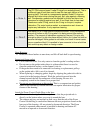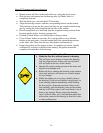• Get close to you subject when shooting underwater
o This will improve the effectiveness of your strobe in
restoring lost color. It will also expand the sharpness of the
image by reducing the amount of backscatter between the
lens and the subject.
• Begin by choosing subjects
o Those that are easy to approach and will not scare off
readily when you approach. Choose subjects that will result
in a large image size. This will make a more dramatic
image.
• Change F/Stops and shutter speeds to “bracket” your exposures
o This will give you a range of image exposures, from which
you can choose the one that you like the best. It improves
the probability of getting a good shot.
• Use flash all the time
o This will restore the vivid colors lost through selective light
absorption. Get to know the full manual power rating of
your strobe, by shooting at a constant distance from an
average reflective subject, and take several shots at
different F/stops.
• Focus lock on your subject
o Practice depressing the shutter release half way, and hold
the focus until you are ready to record the image. If you are
shooting a moving subject, it may be helpful to focus lock
on a nearby part of the coral reef and wait for the subject to
enter into your plane of focus.
• Take lots of shots of any subject or scene
o It is important to vary each shot by changing exposure
settings or composition. This will give you a good sample
of shots from which to select the best one.
20


















